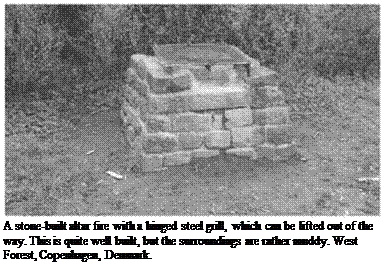These have greater similarity to the suburban barbecue than the campfire type, and so provide a utility for cooking rather than a social event. They are more convenient, as the food can be prepared on a table and moved back and forth without bending down. It is less at risk from dogs, from being kicked or stood on. There are two basic varieties of this type.
The first is the steel pedestal fire. A steel box with an open side and a grill and hotplate is mounted on a steel pole set into the ground. These can be made by a blacksmith or purchased from proprietary makers. The best can be turned to take advantage of the wind direction, have adjustable grills and stay-cool handles. They can be set in a concrete base hidden below ground to deter theft and vandalism. The tops can be detached using special keys, and stored over winter. Treatment with matt-black stove paint helps to prevent them from rusting.
The second type can be constructed from stonework, with a slab of stone as the floor and, if need be, firebricks to make the three sides of the fireplace. A grill can be set into the stonework or laid over the top. This is a substantial structure, which has to be properly constructed to look right. It can be built with an extension for working and storage purposes, possibly surfaced with wood similar to the top of a picnic table. Such structures should be built facing the prevailing wind direction, otherwise getting the fire to draw can be a problem.
Fuel for fireplaces can be wood collected or provided at the site. If wood is not available in some areas such as moors or coasts, or if it is not sufficiently abundant, or if it is ecologically undesirable to be collected in, then it must be provided by the site operator or brought by the users. If wood is provided, a storage bin should be located to service a number of sites. This might even be a shed, as is found in Scandinavia, in order to keep the wood snow free as well as dry. Wood, cut and split into suitable lengths, can then be provided and, if need be, paid for in some way. This requires maintenance and management, so it may only be appropriate on large sites where the costs can be lower or where unregulated collection of firewood causes problems.
Charcoal can be used, especially in the altar types. Users can bring their own; it provides more heat, is easier to carry and produces less ash.
 |
 |
The area around the fireplace is likely to become trampled and have food remains, spilt fat or ashes and cinders around it. This can be unsightly, and so periodic moving of the fireplace might be considered on heavily used sites. Simple rings and steel altar fires can be moved quite easily. Otherwise, harder
surfaces can be provided around picnic tables and fireplaces, which are easier to keep clean and tidy.
Low benches or logs around the campfire types can encourage their use for social purposes. Occasionally, less responsible people are tempted to use the bench tops as fuel, unless they are secured, perhaps by joining them together and anchoring them to chains set into the ground.



